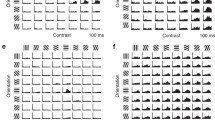Summary
The orientation domain in the cortical visual areas of anesthetized cats has been investigated by employing the 14C-Deoxyglucose technique (Sokoloff et al., 1977).
Orientation subunits (OS) are seen in the first (V1), the second (V2) and the third visual area (V3) as well as in the visual areas of the suprasylvian sulcus. In the latter regions OS are less elaborated than in V1, V2, and V3. The OS are continuous through all cortical layers; in V1 however, only weak label is detected in layer 4C. In V1, V2, and V3 the width of the OS is about 0.4 mm and the average distance between two OS centers is 0.9 mm. The spatial pattern of the OS seems to be more regular in the visual field periphery than in regions representing the vertical meridian.
Similar content being viewed by others
References
Albus, K.: A quantitative study of the projection area of the central and paracentral visual field in area 17 of the cat. II. The spatial organization of the orientation domain. Exp. Brain Res. 24, 181–202 (1975)
Gilbert, C.D.: Laminar differences in receptive field properties of cells in cat primary visual cortex. J. Physiol. (Lond.) 268, 391–422 (1977)
Hubel, D.H., Wiesel, T.N.: Visual area of the lateral suprasylvian gyrus (Clare-Bishop area) of the cat. J. Physiol. (Lond.) 202, 251–260 (1969)
Hubel, D.H., Wiesel, T.N., Stryker, M.P.: Anatomical demonstration of orientation columns in Macaque monkey. J. Comp. Neurol. 177, 361–380 (1978)
Lee, B.B., Albus, K., Heggelund, P., Hulme, M.J., Creutzfeldt, O.D.: the depth distribution of optimal stimulus orientations for neurons in cat area 17. Exp. Brain Res. 27, 301–314 (1977)
Otsuka, R., Hassler, R.: Über Aufbau und Gliederung der corticalen Sehsphäre bei der Katze. Arch. Psychiatr. Nervenkr. 203, 212–234 (1962)
Palmer, L.A., Rosenquist, A.C., Tusa, R.J.: The retinotopic organization of lateral suprasylvian visual areas in the cat. J. Comp. Neurol. 177, 237–256 (1978)
Rogers, A.W.: Techniques of autoradiography. Amsterdam, London, New York: Eisevier 1969
Sanides, F., Hoffmann, J.: Cyto- and myeloarchitecture of the visual cortex of the cat and of the surrounding integration cortices. J. Hirnforsch. 11, 79–104 (1969)
Skeen, L.D., Humphrey, A.L., Norton, T.T., Hall, W.C.: Deoxyglucose mapping of the orientation column system in the striate cortex of the tree shrew, Tupaia glis. Brain Res. 143, 538–545 (1978)
Sokoloff, L., Reivich, M. Kennedy, C. Des Rosiers, M.H., Patlak, C.S., Pettigrew, K.D., Sakurada, O., Shinohara, M.: The 14C-Deoxyglucose method for the measurement of local cerebral glucose utilization: Theory, procedure, and normal values in the conscious and anesthetized albino rat. J. Neurochem. 28, 897–916 (1977)
Author information
Authors and Affiliations
Rights and permissions
About this article
Cite this article
Albus, K. 14C-Deoxyglucose mapping of orientation subunits in the cats visual cortical areas. Exp Brain Res 37, 609–613 (1979). https://doi.org/10.1007/BF00236828
Received:
Issue Date:
DOI: https://doi.org/10.1007/BF00236828




